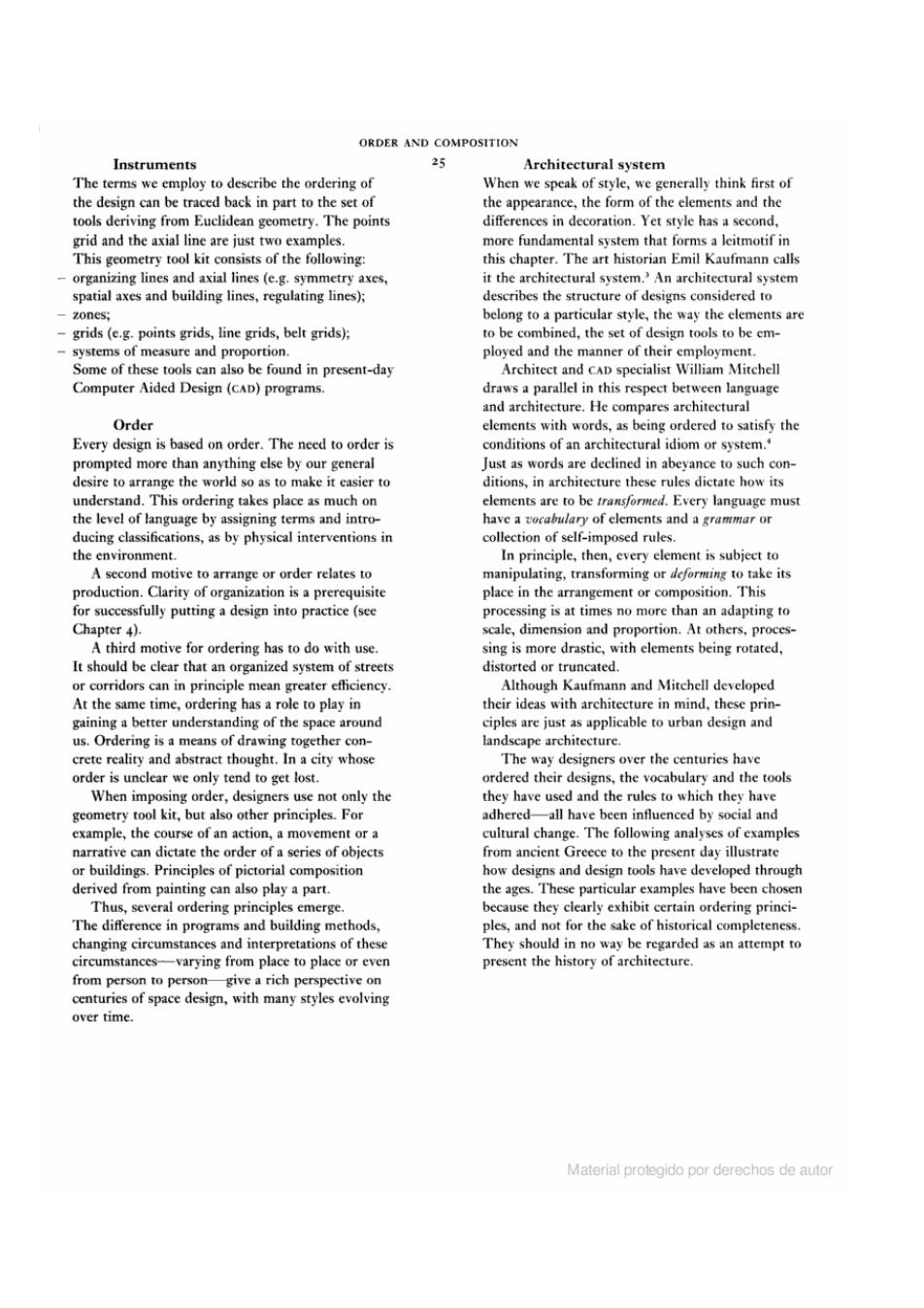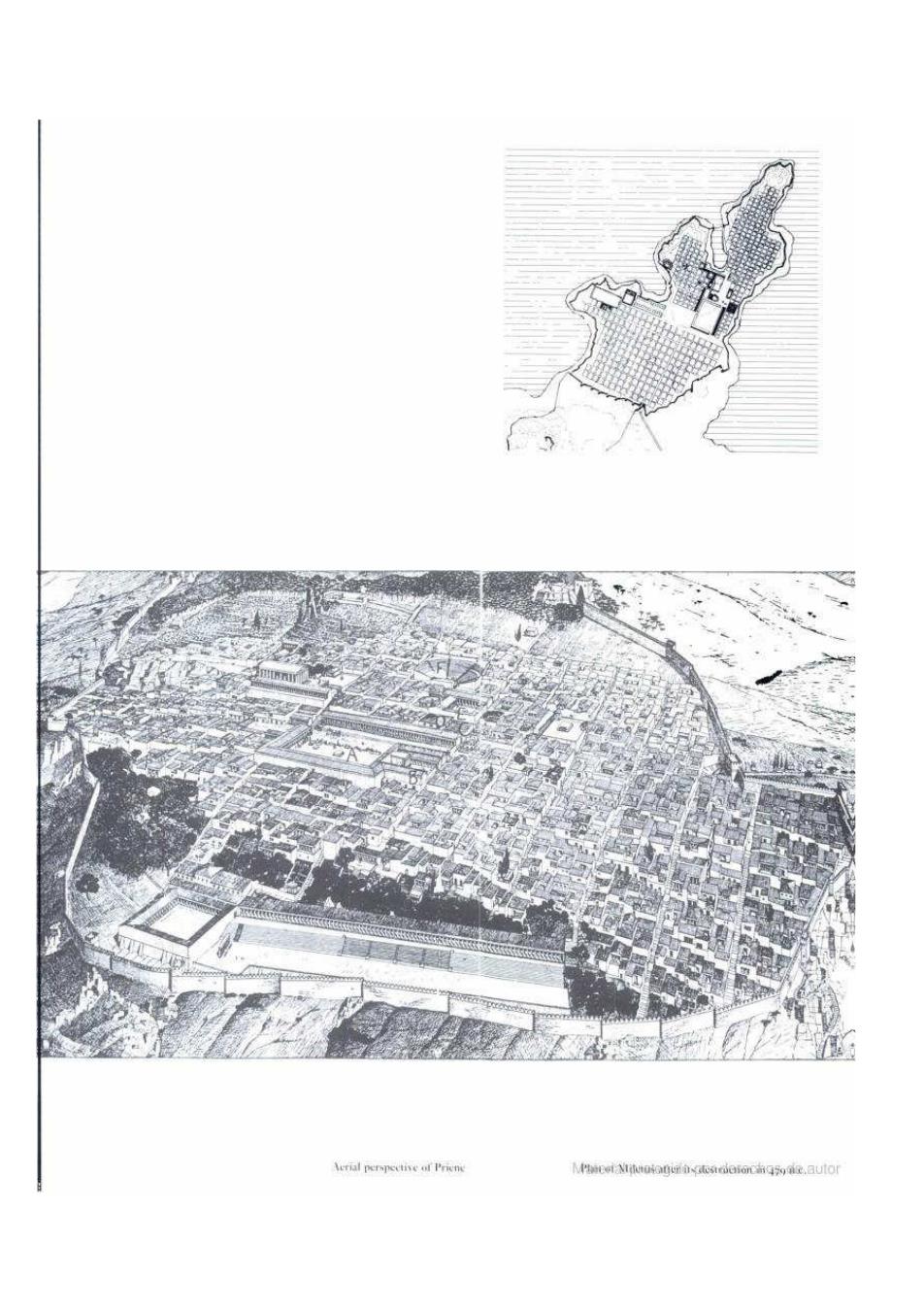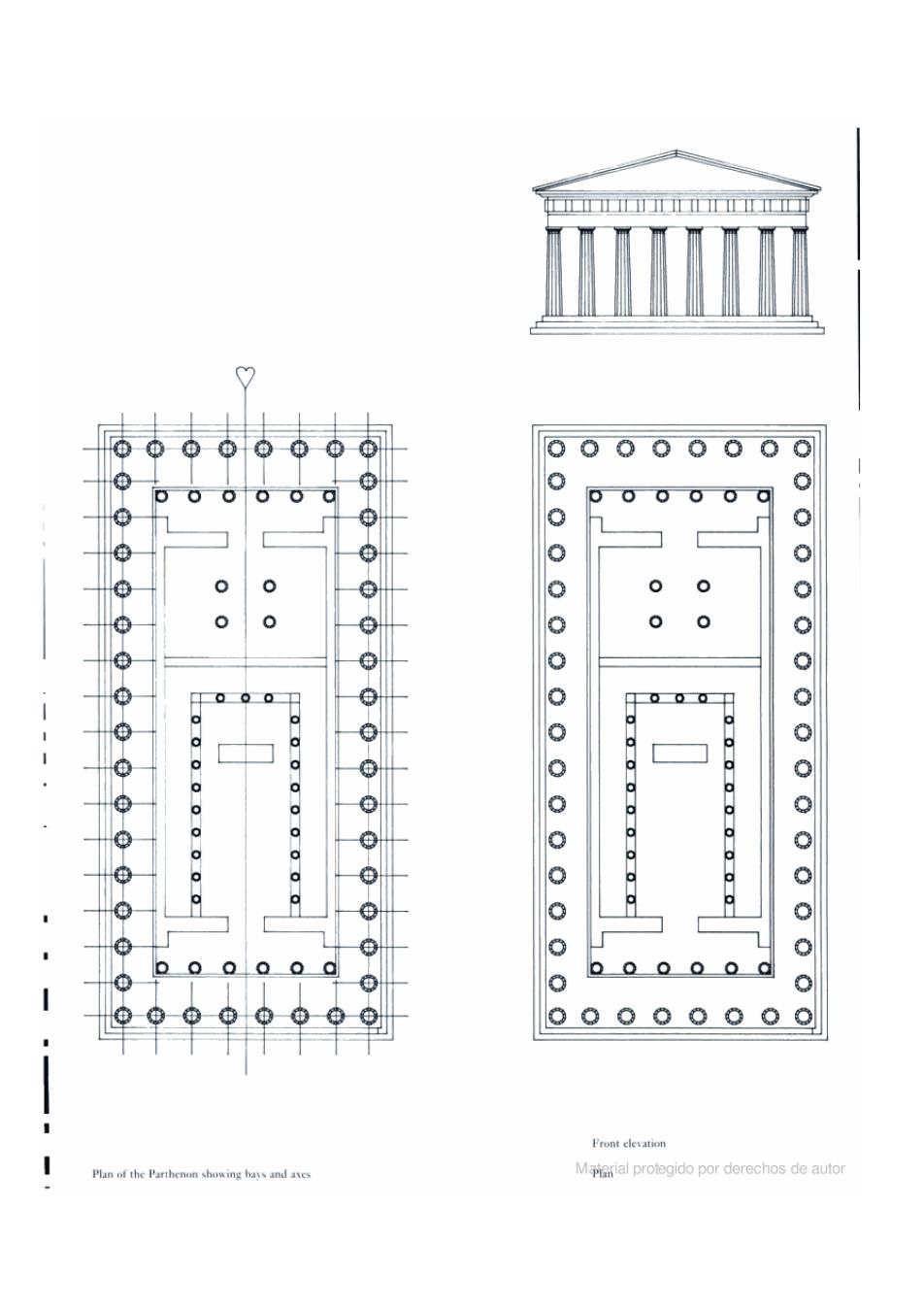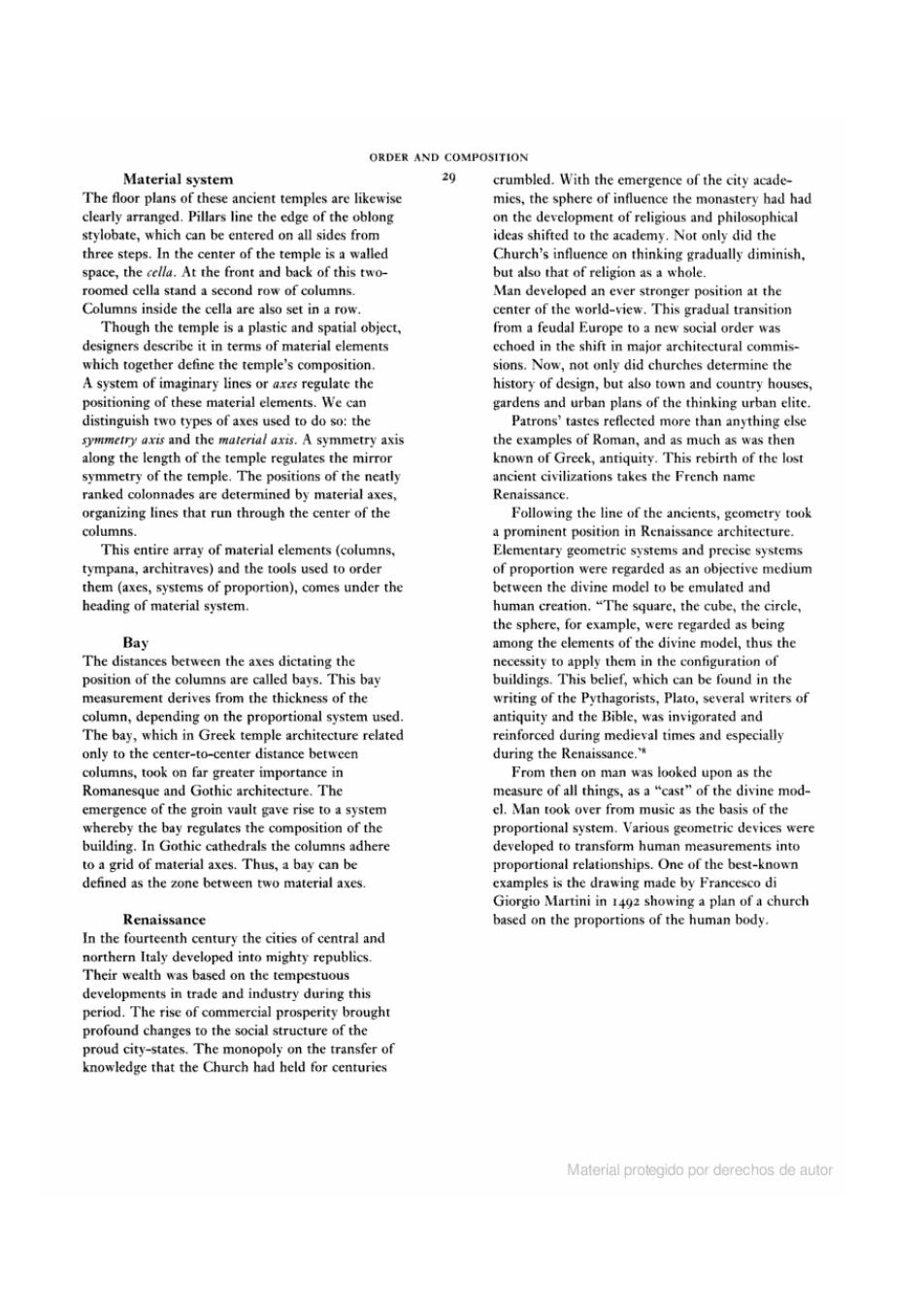
ORDER AND COMPOSITION Instruments 25 Architectural system The terms we employ to describe the ordering of When we speak of style,we generally think first of the design can be traced back in part to the set of the appearance,the form of the elements and the tools deriving from Euclidean geometry.The points differences in decoration.Yet style has a second, grid and the axial line are just two examples. more fundamental system that forms a leitmotif in This geometry tool kit consists of the following: this chapter.The art historian Emil Kaufmann calls organizing lines and axial lines (e.g.symmetry axes, it the architectural system.'An architectural system spatial axes and building lines,regulating lines); describes the structure of designs considered to zones; belong to a particular style,the way the elements are -grids(e.g.points grids,line grids,belt grids); to be combined,the set of design tools to be em- systems of measure and proportion. ployed and the manner of their employment. Some of these tools can also be found in present-day Architect and CAD specialist William Mitchell Computer Aided Design(CAD)programs. draws a parallel in this respect between language and architecture.He compares architectural Order elements with words.as being ordered to satisfy the Every design is based on order.The need to order is conditions of an architectural idiom or system.' prompted more than anything else by our general Just as words are declined in abevance to such con- desire to arrange the world so as to make it easier to ditions,in architecture these rules dictate how its understand.This ordering takes place as much on elements are to be fransformed.Every language must the level of language by assigning terms and intro- have a vocabulary of elements and a grammar or ducing classifications,as by physical interventions in collection of self-imposed rules. the environment. In principle,then,every element is subject to A second motive to arrange or order relates to manipulating,transforming or deforming to take its production.Clarity of organization is a prerequisite place in the arrangement or composition.This for successfully putting a design into practice (see processing is at times no more than an adapting to Chapter 4). scale,dimension and proportion.At others,proces- A third motive for ordering has to do with use. sing is more drastic,with elements being rotated, It should be clear that an organized system of streets distorted or truncated. or corridors can in principle mean greater efficiency. Although Kaufmann and Mitchell developed At the same time,ordering has a role to play in their ideas with architecture in mind,these prin- gaining a better understanding of the space around ciples are just as applicable to urban design and us.Ordering is a means of drawing together con- landscape architecture. crete reality and abstract thought.In a city whose The way designers over the centuries have order is unclear we only tend to get lost. ordered their designs,the vocabulary and the tools When imposing order,designers use not only the they have used and the rules to which they have geometry tool kit,but also other principles.For adhered-all have been influenced by social and example,the course of an action,a movement or a cultural change.The following analyses of examples narrative can dictate the order of a series of objects from ancient Greece to the present day illustrate or buildings.Principles of pictorial composition how designs and design tools have developed through derived from painting can also play a part. the ages.These particular examples have been chosen Thus,several ordering principles emerge. because they clearly exhibit certain ordering princi- The difference in programs and building methods, ples,and not for the sake of historical completeness. changing circumstances and interpretations of these They should in no way be regarded as an attempt to circumstances-varying from place to place or even present the history of architecture from person to person-give a rich perspective on centuries of space design,with many styles evolving over time. Material protegido por derechos de autor

Nerial perspcetive of Priene Mhacei Nituoianur iGtosteaiono.UO

ORDER AND COMPOSITION 2.2 The basic instruments Sitting atop the Acropolis in Athens,it dominates of classical architecture the ancient city.From the front,the temple's com- position is quite basic.On a large platform or stylobate stand eight columns.Above the capital One of the oldest tools for creating order is the grid. crowning each of these is a great stone beam,the This ordering principle is a proven resource for architrave.This assemblage of elements is welded laying out cities.Miletus is often regarded as the into a whole by the tympanum,the large triangular first city to be designed with a grid,yet this end of the saddleback roof. principle can be found earlier in Asia Minor and The elements in this composition are on equal Mesopotamia,and in ancient China cities were footing.A number of fixed ratios serve to already built in this way. harmoniously order the elements(i.e.symmetry)in a system of proportion.This system relates as much Grid to the measurements and proportions of an element The special role assigned to the lonic city of as to those of the entire composition.The Greeks Miletus is probably due to Aristotle (384-322 B.C.) regarded the system of proportion as"frozen mu- who in his book Politica presented the architect sic,"and the absolute proportions it comprises are Hippodamus of Miletus as the originator of the in fact derived from musical harmonies.However. grid-city.By postulating that the grid's equal,non- the various theories on this matter usually have been hierarchic division into blocks ("insulae,"or islands) found to conflict with the evidence of the actual best suited the ideals of democracy.Aristotle gave measurements.The Renaissance architect Alberti the grid-city an ideological charge. (1404-1472)describes the phenomenon as follows: The new plan for Miletus that emerged after the "We define harmony as that consonance of sounds city's destruction in the conflict with the Persians,is which is pleasant to the ears.Sounds may be low- based on a square grid.This grid,which can be or high-pitched.The lower-pitched a sound,the conceived as a system of equidistant and intersecting longer the string that emits it;the higher-pitched. axial lines,sets the center line of the spatial element, the shorter the string.From the different contrasts the street.Where the situation dictated,the fields of between these sounds arise the varying harmonies the Miletan grid might be smaller or larger,rect- which the ancients have classified into set numbers angular or square.A number of blocks were kept corresponding to the relationships between the free in the city center to site the main civic build- consonant strings...Architects employ all these ings and the forum.That the Greeks regarded it as numbers in the most convenient manner possible: an organizing principle without direct aesthetic they use them in pairs,as in laying out a forum, intentions is evident from the way it is draped over place,or open space,where only two dimensions are the uneven ground.s considered,width and length;and they use them also in threes,such as in a public sitting room, Harmony and proportion senate house,hall,and so on,when width relates to In about 30 B.C.the Roman architect Vitruvius length,and they want the height to relate wrote what is arguably the first handbook on archi- harmoniously to both.7 tecture.It gives a clear idea of the aesthetic aims of classical antiquity.Not only did a building have to satisfy firmitas(firmness),commoditas (commodity) and cenustas (delight),architecture for Vitruvius meant order,hierarchy,appropriateness,economy and symmetry.The last concept in Vitruvius refers to harmony,not to the mirror-like connotations the word“symmetry"has today.。 These ideas gained concrete form in Greek temple architecture.One of the most famous Greek temples is undoubtedly the Parthenon (c.449 B.C.). Material protegido por derechos de autor

。 0 0 0 a 0000 o 999999 0 G Front clevation Plan of the Parthenon showing bays and axes Mial protegido por derechos de autor

ORDER AND COMPOSITION Material system 29 crumbled.With the emergence of the city acade- The floor plans of these ancient temples are likewise mies,the sphere of influence the monastery hadhad clearly arranged.Pillars line the edge of the oblong on the development of religious and philosophical stylobate,which can be entered on all sides from ideas shifted to the academy.Not only did the three steps.In the center of the temple is a walled Church's influence on thinking gradually diminish, space,the cella.At the front and back of this two- but also that of religion as a whole. roomed cella stand a second row of columns. Man developed an ever stronger position at the Columns inside the cella are also set in a row. center of the world-view.This gradual transition Though the temple is a plastic and spatial object, from a feudal Europe to a new social order was designers describe it in terms of material elements echoed in the shift in major architectural commis. which together define the temple's composition. sions.Now,not only did churches determine the A system of imaginary lines or ares regulate the history of design,but also town and country houses, positioning of these material elements.We can gardens and urban plans of the thinking urban elite. distinguish two types of axes used to do so:the Patrons'tastes reflected more than anything else symmetry axis and the material axis.A symmetry axis the examples of Roman,and as much as was then along the length of the temple regulates the mirror known of Greek,antiquity.This rebirth of the lost symmetry of the temple.The positions of the neatly ancient civilizations takes the French name ranked colonnades are determined by material axes, Renaissance. organizing lines that run through the center of the Following the line of the ancients,geometry took columns. a prominent position in Renaissance architecture. This entire array of material elements (columns. Elementary geometric systems and precise systems tympana,architraves)and the tools used to order of proportion were regarded as an objective medium them (axes,systems of proportion),comes under the between the divine model to be emulated and heading of material system. human creation."The square,the cube,the circle, the sphere,for example,were regarded as being Bay among the elements of the divine model,thus the The distances between the axes dictating the necessity to apply them in the configuration of position of the columns are called bays.This bay buildings.This belief,which can be found in the measurement derives from the thickness of the writing of the Pythagorists,Plato,several writers of column,depending on the proportional system used antiquity and the Bible,was invigorated and The bay,which in Greek temple architecture related reinforced during medieval times and especially only to the center-to-center distance between during the Renaissance." columns,took on far greater importance in From then on man was looked upon as the Romanesque and Gothic architecture.The measure of all things,as a"cast"of the divine mod- emergence of the groin vault gave rise to a system el.Man took over from music as the basis of the whereby the bay regulates the composition of the proportional system.Various geometric devices were building.In Gothic cathedrals the columns adhere developed to transform human measurements into to a grid of material axes.Thus,a bay can be proportional relationships.One of the best-known defined as the zone between two material axes. examples is the drawing made by Francesco di Giorgio Martini in 1402 showing a plan of a church Renaissance based on the proportions of the human body. In the fourteenth century the cities of central and northern Italy developed into mighty republics. Their wealth was based on the tempestuous developments in trade and industry during this period.The rise of commercial prosperity brought profound changes to the social structure of the proud city-states.The monopoly on the transfer of knowledge that the Church had held for centuries Material protegido por derechos de autor